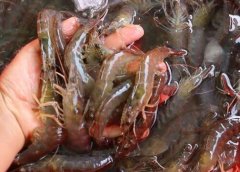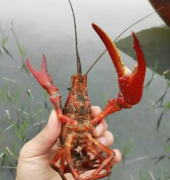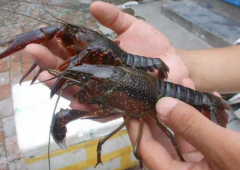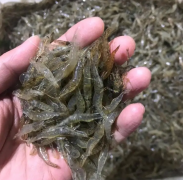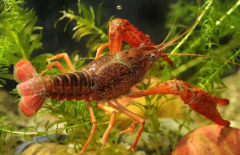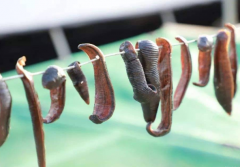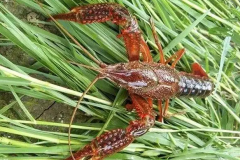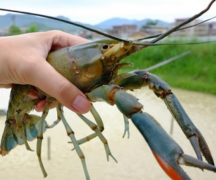海洋一号的介绍
海洋一号,是应国家海洋局要求研制的一颗试验业务卫星,为海洋生物的资源开放利用、海洋污染监测与防治、海岸带资源开发、海洋科学研究等领域服务。
用英语介绍海豚
There is a sonar receiver in the dolphin's brain, and depending on this, they can accurately determine the location of the food. You must have heard the story of dolphins saving people. In fact, dolphins save people not because they are born with the spirit of self-denial, but because their companions are often injured, including themselves. When their companions are injured, they will arch it on the water to inhale oxygen, so they often mistake humans as injured partners, and do their best to arch the water, thus reproducing their touching story of saving people.
对照中文:海豚的大脑里有一块声呐接受器,就靠这个,它们可以准确的确定食物的位置。你一定听说过海豚救人的故事吧,其实海豚救人,不是因为它们天生有舍己救人的精神,而是它们的同伴经常受伤,包括它们自己也是。当同伴受伤时,它们就会把它拱上水面吸氧,所以它们就常常误把人类当成受伤的伙伴,竭尽全力地拱上水面,也就再现了它们救人的动人故事。
扩展资料:
海豚主要栖息于热带的温暖海域,但也有一些比如露脊海豚(Lissodelphis)更喜欢寒冷水域。通常生活在浅水或至少停留在海面附近。
豚泳是海豚科动物独有的游泳方式,整个身体以小角度跃离水面再以小角度入水,这是区别海豚和其他鲸类动物的方法之一(鼠海豚科和其他鲸类动物一般情况下都不会采用这种方式游泳)。
海豚游速迅捷,通常最快速度在每小时30-40km左右,个别种类的海豚时速可以超过55km/h,并能维持很长时间,是海洋中的长距离游泳冠军。
海豚的英语介绍:
The porpoise family evolved from the late Oligocene more than 20 million years ago. There are about 17 genera and 37 species. It is the largest family of cetaceans.
The pilot whale, killer whale and other black whales are also in this family. In essence, they are large dolphins.
The modern relatives of porpoiseae are porpoiseae and narwhalidae, which together constitute the porpoise family.
Dolphin's trunk is spindle shaped, skin is smooth and hairless, body is vigorous and flexible.good at jumping and diving, is the fastest mammal in the water.
During the activity, it mainly relies on the echo location function, and has excellent hearing in water and air.
The nostrils are on the top of the head and are used for water and air exchange. Its shape varies from 1.2m long, 30kg to 9.5m long and 14T.
They have complex sulci, good memory, and can learn many actions under human training. They are one of the animal families with the highest IQ.
They have a gentle, friendly, lively and active character, and are widely loved by people all over the world.
中文释义:
海豚科大约从 2000 多万年前的渐新世晚期进化而来,现存约 17 属 37 种,是鲸类中最大的一科,领航鲸、虎鲸等 黑鲸类 亦属此科,本质上是大型海豚。海豚科的现代近亲为鼠海豚科与 一角鲸科,三科共同构成 海豚总科。
海豚的躯干呈纺锤形,皮肤光滑无毛,身体矫健而灵活,善于跳跃和潜泳,是在水中行动最迅速的哺乳动物。活动时主要依靠回声定位功能,在水中和空气中均有极好的听力。
鼻孔在头顶上,用于出水换气。体型从1.2 米长、30 千克重到 9.5 米长、14 吨重不等,形态特征也各不相同。
它们的大脑沟回复杂,记忆力良好,能在人类的训练下学会许多动作,是智商最高的动物家族之一,有着温和友善、活泼好动的性格,受到世界各地人民的普遍喜爱。
扩展资料:
海豚不像其他鲸类那样长时间深度潜水。游速快并带有杂耍特征。豚泳是海豚科动物独有的游泳方式,整个身体以小角度跃离水面再以小角度入水,这是区别海豚和其他鲸类动物的方法之一。
海豚游速迅捷,通常最快速度在每小时30-40km左右,个别种类的海豚时速可以超过55km/h,并能维持很长时间,是海洋中的长距离游泳冠军。
参考资料来源:百度百科―海豚
1. 简介:
Any of various marine cetacean mammals, such as the bottle-nosed dolphin, of the family Delphinidae, related to the whales but generally smaller and having a beaklike snout.
译文:海豚:一种海豚科海洋鲸类哺乳动物,如的宽吻海豚,与鲸近似但一般比鲸小且有喙状吻
2. 详细介绍:
dolphin, aquatic mammal, any of the small toothed whales of the family Delphinidae, numbering more than 50 species. These include the true, or beaked, dolphins, the killer whale, the pilot whale, and 12 freshwater species found in rivers of South America and S Asia. Most species are highly gregarious. The name dolphin, meaning “beaked,” is also applied to a species of fish (see dolphin, fish). In the United States dolphins are often mistakenly called porpoises, a name correctly applied to small, blunt-nosed whales of another family. Until recently dolphins formed the basis of a widespread fishing industry; only the Japanese continue to hunt them for food on a large scale. They are accidentally caught and killed in large numbers in tuna seining operations.
Characteristics and Species
Dolphins are fishlike in form, with streamlined, hairless bodies. Their powerful, horizontal flukes, or tail fins, drive them through or out of the water, while their forefins and dorsal fin are used for steering. Constantly shedding their skins, dolphins accumulate no barnacles or other external parasites. A layer of blubber protects them from cold and seals small wounds. Dolphins breathe air through a single, dorsal blowhole.
The dolphin's intelligence, playfulness, and friendliness, its built-in smile and merry-looking eyes have been a source of interest and enchantment to human beings from earliest times; it is a common figure in mythology and literature and has been much depicted in art, especially in the posture of its graceful, arched, 30-ft (9-m) leap. Dolphins have long been famous for riding the bows of ships, and it is now known that they also ride the bows of large whales. Today they are valued and exploited as entertainers in more than 40 water shows around the world and have thus become available for extensive study.
The best known species are the common dolphin (Delphinus delphis), of worldwide distribution, and the bottle-nosed dolphin (Tursiops truncatus), found in coastal waters of the North Atlantic Ocean and the Mediterranean Sea. The bottlenose has been particularly intensively studied; it is presumed that much of what is known about this species applies to other dolphins and even to the large whales.
Common Dolphin
The common dolphin averages 8 ft (2.4 m) in length and 165 lb (75 kg) in weight. It has a dark blue or black upper body, a white underbody, golden stripes on the sides, and a sickle-shaped dorsal fin. Its pronounced, slim beak, holding 100 teeth, is separated from its snout by a deep groove. A fast swimmer, it travels in large schools in warm waters and is noted for leaping alongside boats for long distances. Its life span is about 50 years.
Bottle-nosed Dolphin
The bottle-nosed dolphin is blue-gray with a dorsal fin and white belly. Its average length is 9 ft (2.7 m) and its average weight 350 lb (160 kg). Its domed forehead, called the melon, contains an oily substance thought to protect the brain case and to act as an acoustic lens. With age the 200 or more teeth of the bottlenose wear down, hence the name truncatus. Members of this species live about 25 years. Bottle-nosed dolphins swim in large schools with a social organization and hierarchy, hunting the small fish, crustaceans, squid, and cuttlefish that make up their diet. They have been clocked swimming at 30 mi (48 km) per hour, although 20 to 24 mi (32C39 km) per hour is their usual speed. They can dive 70 ft (20 m) and remain underwater for 15 minutes. They sleep by night, just below the surface of the water, rising for air every three or four minutes.
Their aquatic natural enemies are sharks and killer whales; these they attempt to outswim, using complex evasive strategy, or batter to death, acting in a group. If one of their number is injured or sick they make every effort to rescue it, holding it above the water for air. Play behavior is highly developed in the bottlenose from infancy through old age, and in this connection it displays considerable tool-making, tool-using, and manipulative ability; for example, a dolphin has been observed to kill a fish, strip its skeleton, and use the bones, held in the mouth, to pry another fish out of a crevice. Sex play is frequent and is initiated by any individual toward any other, without regard to size, age, sex, relationship, or even species; approaches to human beings and to turtles are common.
Courtship and impregnation occur mainly in spring, when males vie for the attention of the females. A single calf, 3 1/2 ft (97 cm) long and weighing 30 lb (14 kg), is born tail first after a gestation of 12 months. The mother or a female assistant bites the umbilical cord in two and pushes the calf to the surface to breathe; it is nursed for one to two years. One female may watch over several calves while the mothers hunt, or during battle.
The senses of the bottlenose have been subjected to intensive investigation, as have their intelligence and their remarkable systems of echolocation and communication. In relation to body size, the brain of the adult bottlenose is comparable in size to that of humans; it is twice as convoluted and possesses 1 1/2 times as many cells. The bottlenose has partially stereoscopic vision that is keen both in water and in air; when the animal leaps from one medium to the other, its brain corrects for the difference in refractive index. The eye has a glowing layer for night vision and a brownish filter that is lowered over the iris in bright sunlight. The brain has no olfactory lobe and the sense of smell is presumably missing, but the taste buds are well developed and are used to detect underwater chemical traces, as when the dolphin tracks fish.
Echolocation and Communication
Dolphins produce an enormous variety of sounds, up to frequencies ten times those heard by human beings. The sounds are apparently produced by a complex of anatomical structures including the blowhole with its air sacs and valves. Each dolphin has a signature whistle with which it identifies itself; a calf soon learns to recognize its mother's whistle. Clicking and rapid creaking sounds are the basis of the echolocation mechanism (sonar) with which the dolphin gathers extremely precise information about the size, location, and nature of surrounding objects. Dolphins communicate by means of a demonstrably descriptive language understood by more than one species, using all the sounds in their repertory. They are observed to converse, and it has been repeatedly shown that one animal can convey instructions to another. Computer-aided efforts are being made, so far without success, to learn the dolphin language and to teach dolphins human speech, either in its normal form or translated into whistle combinations.
Interaction with Humans
Dolphins are capable of imitation and memorization; they demonstrate foresight, learn from observation, communicate experience, solve complex problems, perform elaborate tasks, and learn multiple procedures simultaneously. Their so-called training is in fact a discipline structured around play, using their natural behavior as the basis for involved maneuvers; they appear to perform primarily for their own enjoyment. In situations of great stress in captivity they have been known to commit suicide by starvation, battering against walls, or drowning. There are many reports of dolphins rescuing people from drowning.
The United States and Russian-Soviet navies have spent vast sums to reach a greater understanding of dolphin echolocation, which could have countless military applications. The U.S. navy has trained dolphins to act as messengers to underwater stations, to rescue wounded scuba divers and protect them from sharks, to locate and mark underwater mines, and to seek and destroy submarines, using kamikaze methods; this last project has met with considerable public criticism.
dolphinfish:
large
slender
food
and
game
fish
widely
distributed
in
warm
seas
(especially
around
Hawaii)
